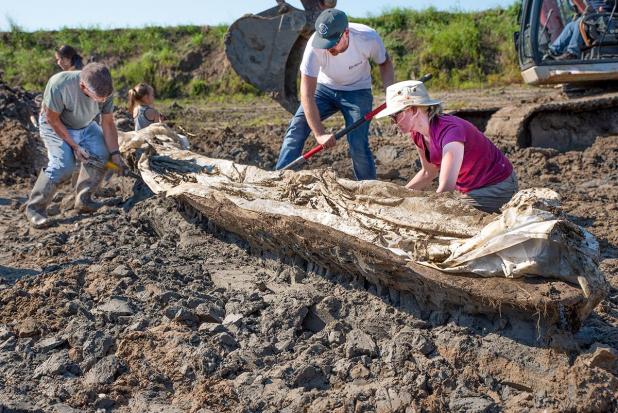
This Chitimacha dugout canoe has rested beneath some 30-foot of earth for 1,500 years
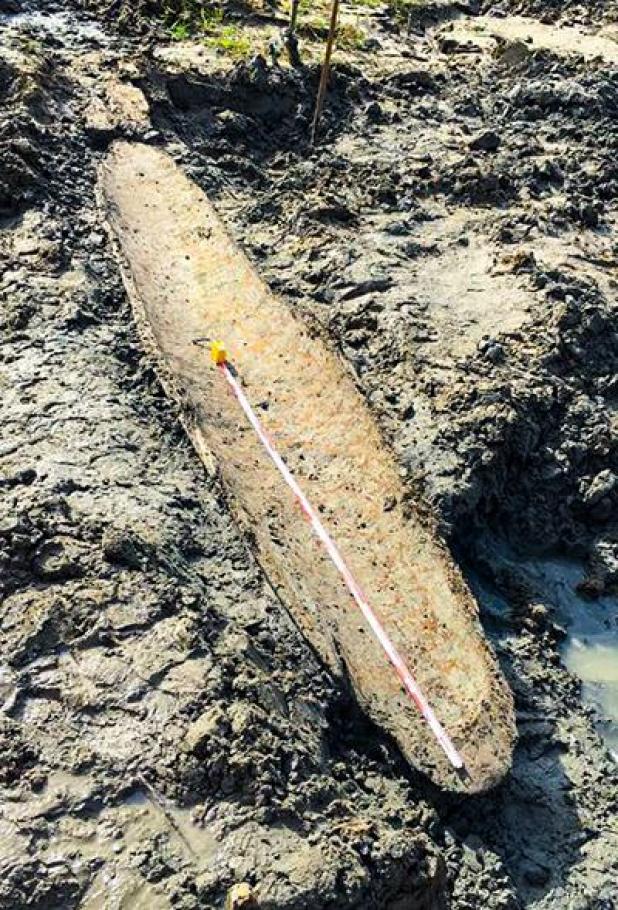
The first full view after Ponville located the dugout, then re-covered it, a year ago.
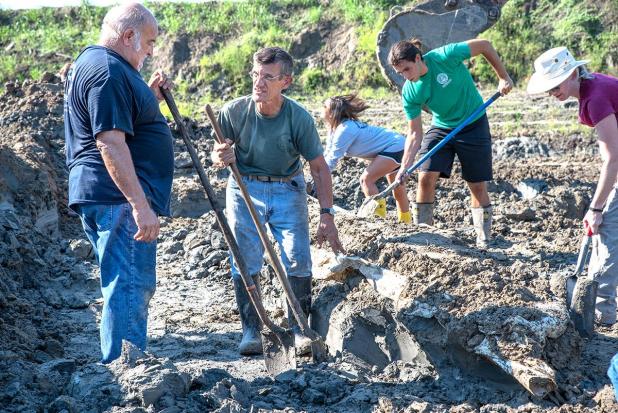
State Archaeologist Dr. Charles "Chip" McGimsey, center, oversees the excavation
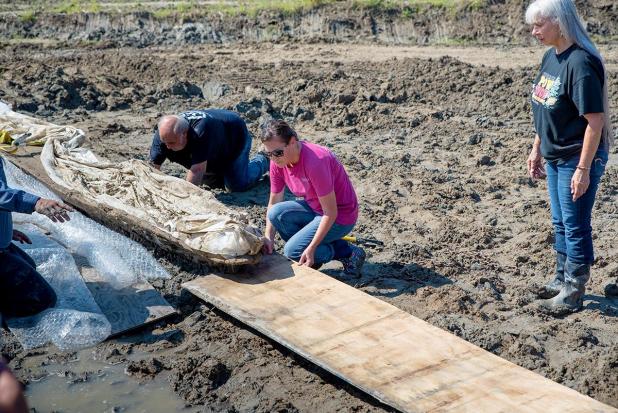
Chitimacha Cultural Department Director Kimberly S. Walden, and Tribal Council Secretary-Treasurer Jackie Junca, center and at left, as plywood is being inserted to support the canoe.
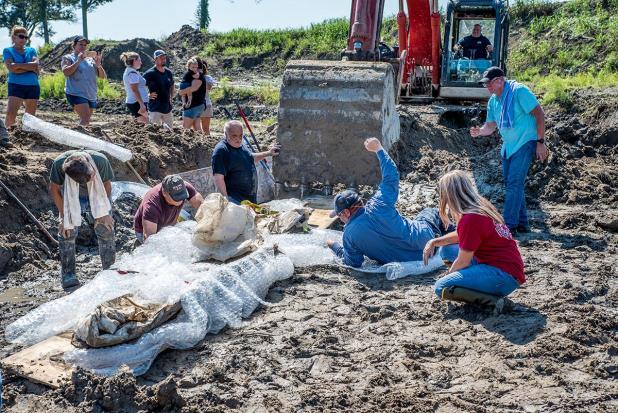
Jamie Ponville, in blue at center guiding the excavator bucket, is the finder of the vessel.
DugOut
By ROGER EMILE STOUFF
Managing Editor
A long, long time ago, someone in southern Louisiana, or perhaps several people, cut down a cypress tree and made a boat.
Well, not a “boat” per se, but a dugout canoe. It wasn’t an Acadian, ousted from their home in Nova Scotia, who fashioned it; nor was it a living member of the many Native Americans living in the swamps and bayous when the Cajuns arrived. But it was one of their ancestors.
Just south of Donaldsonville, Louisiana in Belle River, Jamie Ponville owns a dirt-fill business that he excavates from a very large and deep site. Last October, the excavator’s bucket struck something and Ponville knew what it was on sight.
“My father and brother were moving some material for me,” Ponville said. “I had a little puddle of water that was standing in the middle of the pit and I wanted to get it out to my drainage ditch. So I just started scraping the ground, just about an inch at a time…and I exposed, in the ground, about a six-inch piece. It was a perfect V, about six inches on each side. And right away, the feeling that came over me, it’s unexplainable.”
He knew what it was. “I called my wife, and I said, ‘Baby, start heading to the dirt pit because I just uncovered a dugout canoe.”
***
No one can know whose hands felled that tree or shaped and hollowed that log, likely used for fishing and visiting neighboring villages of the Chitimacha nation, who pre-contact occupied about a third of southern Louisiana. No one can know if it was grounded there, or washed away by a tide, or lost by its maker, or discarded when it was time to build another.
But in some way, it found its place not far from Bayou Lafourche, which the very earliest European explorers named, “River of the Chitimachas.”
The vessel Ponville discovered lay some 30-foot lower than the surrounding terrain.
“My wife, she said, ‘Jamie, you crazy?’ I told her start heading this way because I’m 99.9 percent sure that is what it is.”
He began carefully digging along the right side, following the V-shaped pattern about 14-foot on the right side, then the left. That revealed an outline some 2½ foot wide and 14-foot long.
“My heart’s fixing to jump out of my shirt,” he laughs. “If this thing start coming back inward (in shape) or it comes to a point or roundness in the back, it’s what I think it is.”
And it did what he expected. He began digging out more. “It was absolutely amazing,” he said. “I wish more people could experience the feeling I felt. It’s awesome.”
In contemplating the depth, Ponville said his thoughts were, “What in hell is this thing doing down here? This thing does not belong down here. So I started thinking how long would it take for Bayou Lafourche to fill up this much sediment. I’m coming up with all kinds of calculations.”
The flooding and moving of that bayou are evident in the soil strata as Bayou Lafource aged since the time the dugout settled there.
“I got several people to come look at it just to make sure I wasn’t going crazy,” he said.
A friend of Ponville’s contacted the Louisiana Department of Archaeology, and reached state archaeologist Dr. Charles “Chip” McGimsey. “Didn’t tell him who I was or where I found it, just what I found and the depth,” Ponville said.
***
Ponville, like most people who are unfamiliar with the laws concerning antiquities, was concerned about the ramifications such a find might have on his business and livelihood.
Many times when such artifacts are found, landowners are reluctant to contact relevant experts or agencies. Kimberly S. Walden, Chitimacha Tribal Cultural Department Director, said that is “an unfortunate concern” that was remedied.
In Louisiana, there are laws that protect unmarked burials of human remains.Those laws mirror the Archaeological Resources Protection Act. Essentially, a burial site on private property is protected in the same manner as a cemetery, and remains can be relocated by the tribal entity. But the dugout did not exist in a burial context.
“I couldn’t afford to take a chance to have someone come out and say you cannot dig in this location anymore,” Ponville said.
McGimsey explained the process and legal limits. He and a colleague visited the site, and the colleague asked, “Jamie, you buy a lottery ticket lately?”
“No, ma’am, I have not,” he replied.
“Maybe you need to,” she said, “if you found a canoe in here!”
McGimsey’s interest was clearly piqued, Ponville said. He asked to dig more and Ponville agreed. The archaeologist documented as much as possible, then it was covered again.
The process of getting to the point of excavation took months. Ponville said the state was paying for preservation of a canoe found on the Red River and had no more funds. But McGimsey had carbon dating performed. “I said if you wake up in the middle of the night to go to the bathroom and you get an email from the lab in Miami, just give me a call,” Ponville said.
In two weeks, the results were in: The dugout is over 1,500 years old, making it more than 400 years older than the next oldest found in Louisiana.
“I was notified about the find near Bayou Lafourche, which the older name of was River of the Chitimachas,” Walden said. “We have sites above and below this location. Of course I was excited that it was most likely ours.”
Walden contacted Ponville to begin discussions, including his wishes to preserve the find. “We talked about plans for display after the preservation,” she said. “I offered to either display it here on a short or long term loan, and he’s still undecided…however, he does want people to see it, he’s very proud of his find.”
Ponville agreed to pay the cost of preservation, though the tribe offered to cost-share, especially if the dugout would be loaned to the tribe for viewing. He intends to maintain his ownership but has been agreeable to working with the tribe.
“There was an archaeologist out there, and he said the Red River canoe was used for long-distance travel,” Ponville recalled. “And we have your canoe, used for everyday use. Two totally different canoes,” based on the size and shape. “He said this canoe was used every day for regular travel.”
***
The dichotomy of archaeology is that while scientists can unearth artifacts and more often than not glean meaning and use, but ideas do not fossilize. In southern Louisiana, where there is no native stone, this is compounded by a soil and environment that are counter-conducive to preservation of biological remains, such as bone and hides.
It was Walden’s first visit to the site, along with a crew of tribal members and officials. During the hours-long, delicate and careful excavation, she participated in preparing the vessel for relocation. She was, in that process, able to touch the wooden dugout.
Bear in mind, this is a Chitimacha person experiencing tactile connection with ancestors a millennia-and-a-half in the past.
“It’s only happened to me once in the past,” Walden said. “It’s just amazing to be in the exact same place. At another site, that was on the map as a Chitimacha site, I knew I was in the exact same place. I got to actually kneel where a tribal woman knelt between 1350 and 1700, processing rangia clam.
“I fit in her knee impression, her leg impressions, where all the shell had fallen around her. That’s the closest equivalent to this that I can compare to this. It was just an amazing feeling.”
As for the dugout, it falls within the period established within Chitimacha timeline, but “as far as vessels go, it’s the oldest we know of from a Chitimacha site. And it also is an issue that I’m challenged with when we’re trying to protect or get more information along the Mississippi, Bayou Teche, Bayou Lafourche, all of those bodies of waters the Chitimacha lived around.
“A lot of people want to write-off sites because they would have been damaged by plowing and agriculture,” Walden said. “We’ve found sites below the plough zone. This is probably the deepest cultural deposit. You can’t just rule out that the land has been disturbed and there’s nothing below the plough zone.”
The dugout lies within an older channel of Bayou Lafourche, but there was deposition of silt and overflow from when it was the river’s route. “We’re going to look at the hydrology and the geomorphology of the area as well,” she said.
Walden urged people who have what might be culturally significant items to reach out to the tribes. “It’s not that we want their land or will stop anything, but we’d like to have these things documented and preserved.”
The dugout was moved Sunday to Texas A&M. Preservation involves soaking the dugout in glycol solution. The glycol displaces the moisture in the wood and preserves the structure and prevents cracking. It will take 3-5 years to complete that process.
Ponville, when asked about working with Chitimacha, said, “Let me put it this way: You couldn’t have asked for a better working relationship with the tribe. I don’t think it could get any better.
“There was no doubt,” the canoe would be saved, he added.
***
It may be difficult to comprehend today that when Europeans arrived and later encountered the Chitimacha, they were considered the most significant and influential, as well as powerful, tribe from Texas to Florida. Conflict was inevitable, and a long war with the French that ended in 1718 led to near-annihilation. By the late 1800s, early 1900s there were very few left, but they persevered and today number well over a thousand.
They are the only Louisiana tribe that still reside on a sliver of their ancestral lands and waters. “Chitimacha” is a Europeanized derivation of Siti imaxa, meaning “people of the many waters.” Upon that third of Louisiana they occupied pre-contact, most of it was water, and vessels such as the one Ponville discovered were abundant.
Scientists have various estimations of how long these people have lived in the southern reaches of Louisiana. Artifacts and evidence provide some indications, but if you ask most Chitimacha, they will likely say, “We have always been here.”
Perhaps new discoveries await, in the ground, beneath the waters, that will one day show they were right all long.
